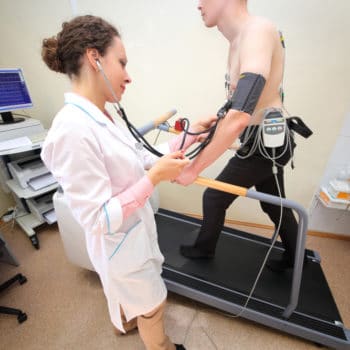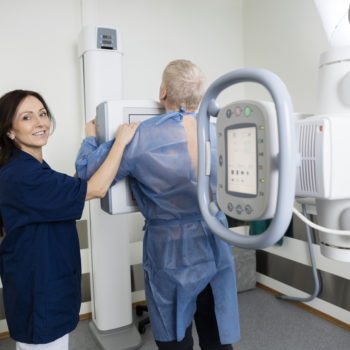Why We Love It
-
$31,910Potential Avg. Salary
-
23.5%Job Growth Rate
-
Growing DemandJob Outlook
-
Dependable Daily WorkloadCareer Attribute
Medical assistants are healthcare professionals that handle many of the administrative and minor clinical responsibilities in doctor’s offices, outpatient clinics, and hospitals. Medical assistants commonly update patient medical records, schedule appointments, take patient vitals, and perform immunizations.
Recommended Schools
What is a Medical Assistant?
The following job responsibilities are common for individuals in medical assistant roles:
- Measure patients’ heights, weights, and vital signs prior to visits with doctors
- Discuss medical concerns with patients, and provide reports to doctors
- Collect bloodwork for lab tests, provide immunizations, and collect samples for in-office tests
- Schedule appointments for patients, collect identification and insurance information, and call patients to deliver test results
- Clean and disinfect medical equipment and exam rooms before and after use
A Day in the Life
Medical assistants enable physicians to see a greater number of patients by handling many of the administrative and minor clinical tasks that keep doctor’s offices and hospitals running. When patients arrive, they’re commonly greeted by medical assistants that perform receptionist duties. They deliver required forms to patients, collect and process insurance information, answer questions, and accept payments for services. They also handle appointment scheduling and updating patient medical records.
Other medical assistants help doctors perform minor clinical tasks. These assistants escort patients from waiting rooms to exam rooms, and commonly measure vitals before examinations. They measure the height and weight of patients; test blood pressure, temperature, and oxygen levels; and discuss symptoms and other medical concerns with the patient. They then update the patient’s record with all of this information so that physician has access to needed information during the exam.
The medical assistant often returns after the exam to deliver prescriptions, answer any questions that patient has, and administer immunizations. He/she may also provide literature to the patient that explains what side effects and symptoms are normal—and what are abnormal—to experience after starting a new medication or receiving an injection. If the patient needs to return to the office for a follow-up visit, the medical assistant may schedule the follow-up appointment with the patient.
Typical Work Schedule
Most medical assistants work full-time schedules. Those that work in doctor’s offices may work normal business hours, but those that work in hospitals commonly work irregular shifts that include evenings, overnight shifts, weekends, and holidays.
Projected Job Growth
Demand for medical assistants is expected to increase significantly in the coming decade due to two major factors: an increased need for healthcare among the large, aging Baby Boomer generation, and greater access to health insurance—and subsequently healthcare—among the general population.
Typical Employers
More than half of all medical assistants are employed to work in doctor’s offices. However, many also find work in hospitals, outpatient clinics and care centers, and nursing homes.
Recommended Schools
How To Become a Medical Assistant
The requirements for working as a medical assistant can vary by state, by employer, and by the responsibilities you hope to perform in the role. It’s possible to work as a medical assistant with only a high school diploma, but you’ll likely only be able to perform administrative tasks like appointment scheduling and medical records updating and management. Additionally, some states may require postsecondary education by law, and some employers prefer to hire candidates with certificates.
The simplest way to increase your chances of finding work as a medical assistant is to pursue a medical assistant certification from a vocational or trade school. These programs teach students important concepts and techniques, and include theoretical, laboratory, and practical coursework. By earning a certificate, you’ll reduce the amount of on-the-job training your employer must conduct when you’re hired, making you a more competitive candidate over individuals with no experience or training.
Some states also require that medical assistants are licensed—a process which requires completion of a certification program and passing an examination. Licensed medical assistants can often perform more clinical tasks like administering immunizations, taking blood samples, and conducting minor tests for illnesses like strep throat or the flu. Having this clinical experience can be beneficial for medical assistants who want to move into more prestigious roles over the course of their career, taking nursing, paramedic, or doctor positions after completing additional educational requirements.
Medical Assistant Salary Data
We’ve provided you the following to learn more about this career. The salary and growth data on this page comes from recently published Bureau of Labor Statistics data while the recommendations and editorial content are based on our research.
National Anual Salary
Low Range
$26,080Average
$31,910High Range
$43,880National Hourly Wage
Low Range
$13/hrAverage
$15/hrHigh Range
$21/hrHow do Medical Assistant salaries stack up to other jobs across the country? Based on the latest jobs data nationwide, Medical Assistant's can make an average annual salary of $31,910, or $15 per hour. This makes it an Above Average Salary. On the lower end, they can make $26,080 or $13 per hour, perhaps when just starting out or based on the state you live in.
Salary Rankings And Facts
#669 Nationally for All Careers
Programs and Degrees
Here are the most common degrees for becoming a Medical Assistant. a is usually recommended and specifically a degree or coursework that prepares you for the particular field, see below.
Highest Education Among Medical Assistants
- 0.8% Doctorate
- 1.2% Masters
- 7.7% Bachelors
- 22.3% Associates
- 42.7% College
- 22.5% High School
- 2.7% Less than High School
Job Growth Projections and Forecast
2014 Total Jobs
591,3002024 Est. Jobs
730,200Job Growth Rate
23.5%Est. New Jobs
138,900How does Medical Assistant job growth stack up to other jobs across the country? By 2024, there will be a change of 138,900 jobs for a total of 730,200 people employed in the career nationwide. This is a 23.5% change in growth over the next ten years, giving the career a growth rate nationwide of Below Average.
Growth Rankings And Facts
#34 Nationally for All Careers
What Companies Employ The Most Medical Assistants
| Industry | Current Jobs | New Jobs Needed | % Increase |
|---|---|---|---|
| Offices of physicians | 351,300 | 79,200 | 79% |
| General medical and surgical hospitals; private | 67,900 | 4,800 | 5% |
| Offices of chiropractors | 25,200 | 4,600 | 5% |















